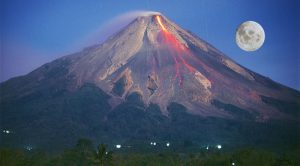A Working Paper
Merapi, History and Future Changes – Merapi Volcano, in the central part of Java, is regarded as the most active and most dangerous volcano in Indonesia. Merapi is a young stratovolcano with a total volume estimated between about 100 and 150 km3, according to the importance given to the Pre-Merapi (Berthommier, 1990). A strong uncertainty remains concerning the beginning of its activity. Information on Merapi eruptive activity is scattered. A concise and well-documented summary of this activity has been long needed to assist researchers and hazard-mitigation efforts. The present effusion rate is about 105 m3/month (Siswowidjoyo et al., 1995); if we assume a constant rate since the beginning, Mount Merapi could be between 8300 and 125 000 years old. On the basis of field studies and geochronological data, its history is divided into four Periods: Ancient, Middle, Recent and Modern Merapi. The Ancient Period may have begun around 40 000 y BP and lasted until 14 000 y BP when the Middle Period begun. The Recent Period begun around 2200 y BP and was replaced by the Modern Period after the eruption of 1786.

Modern Merapi is characterised by the persistent growth of a summit dome, periodically interrupted by partial or total collapse of the dome to generate frequent Merapi-type nue ´es ardentes (blocks-and-ash flows and associated surges), or more exceptionally, fall-back St. Vincent type nue ´es ardentes (scoria flows). In contrast, previous stages were characterised by effusion of long lava flows, alternating with violent explosive phases, generating essentially St. Vincent-type nue ´es ardentes. Merapi has behaved as a classical stratovolcano, with alternating phases of effusion of lava flows, and vertical vulcanian explosions generating scoria flows. The major event that interrupted this behaviour was a sector collapse, with an inferred associated blast. Later, strong magmatic and probably phreato-magmatic events occurred, preceding the present dome-building phase.
Hartmann (1935a) believed that the Merapi eruptions seemed to evolve according to several general patterns. Hartmann classified activity intofour groups, which he inferred to be related to the gas content of the erupting magma. The classes, A, B, C, and D, were arranged in order of increasing explosivity. Hartmann’s classification has been used by many researchers at Merapi (e.g. Van Bemmelen, 1949, pp. 199–200), although a few authors have reported problems in application (e.g. Ratdomopurbo and Poupinet, 2000).
Class A activity is associated with gas-poor magma which rises through the vent and spreads itself into a dome or a tongue-like coule ´e. It may extrude through B. Voight et al. / Journal of Volcanology and Geothermal Research 100 (2000) 69–138 74a pre-existing solidified dome structure. Small initial explosions commonly accompany eruption onset, and dome growth may produce dome-collapse nue ´es ardentes. Based on his limited observations, Kemmerling (1921) expected nue ´es from dome collapse to remain small. However, events since the 1920s have proved that moderate-sized nue ´es, with relatively long runouts, sometimes occur with this class of activity. Because of the low … Read more
*Geo-information for Spatial Planning and Risk Management — Batch 6 — Faculty of Geography, Gadjah Mada University*